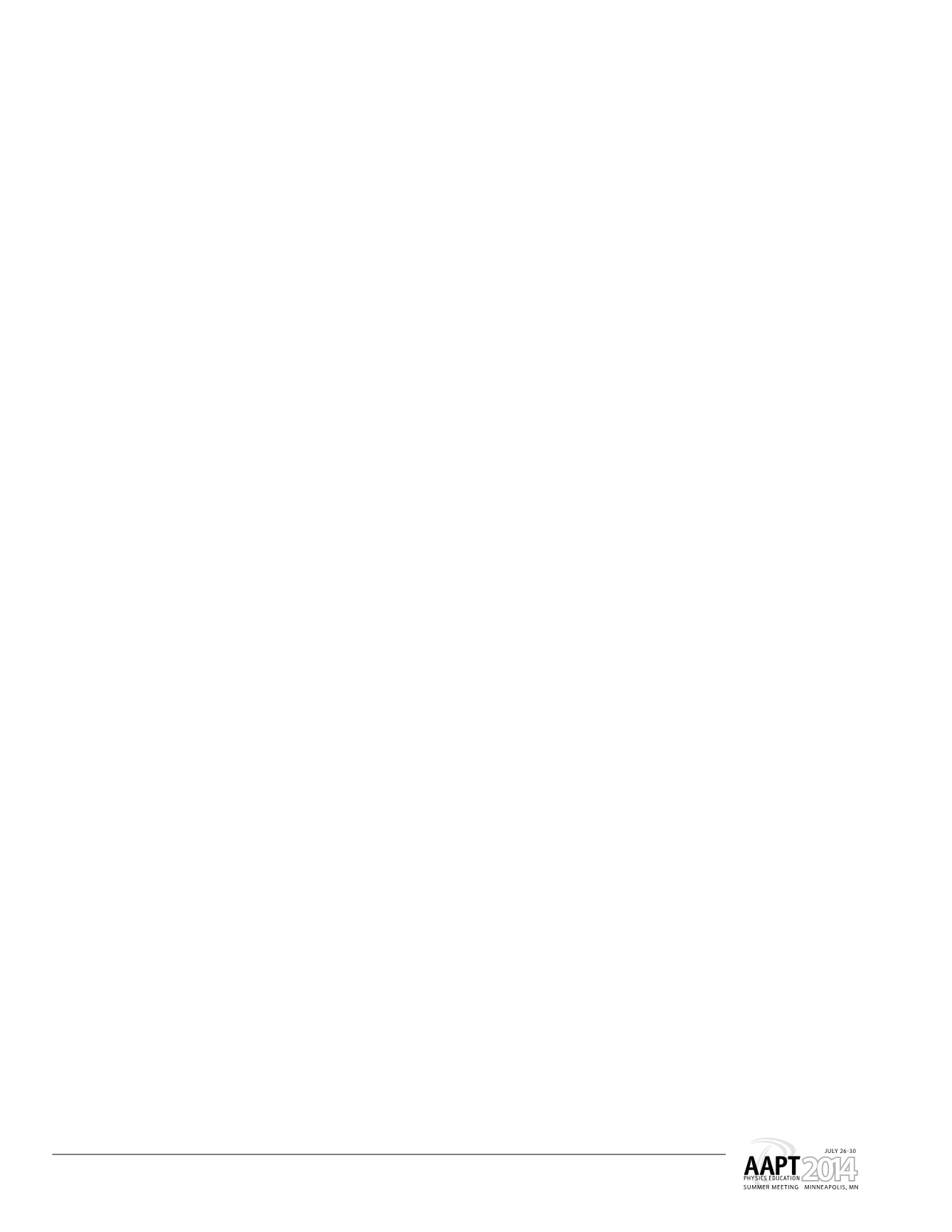
32
Workshops – Saturday, July 26
All workshops are held at the University of Minnesota
T01: Not Everyone Wants to go to Graduate School: How to
be an Effective Mentor for “the Other 40%”
Sponsor: AAPT/SPS
Time: 9 a.m.–12 p.m. Saturday
Member Price: $60
Non-Member Price: $85
Location: STSS 117
Toni Sauncy, One Physics Ellipse, College Park MD 20740;
Roman Czujko
This workshop is intended to empower educators who have an interest
in improving outcomes for undergraduate students who desire to enter
the STEM workforce following the baccalaureate degree. The AIP Career
Pathways project, funded by NSF, has identified a set of common features
and developed mentoring guidelines for faculty and advisors that will be
presented in this interactive workshop session. The content of the work-
shop is based on analysis of information gained during site visits to physics
programs at a range of institution sizes, types and locations, all with a
strong record of students who successfully found satisfying STEM employ-
ment following graduation.
T02: GlowScript: An Easy-to-use Programming Environ-
ment for 3D Browser Animations
Sponsor: Committee on Educational Technologies
Time: 1–3 p.m. Saturday
Member Price: $60
Non-Member Price: $85
Location: STSS 312
Bruce Sherwood, 515 E. Coronado Road, Santa Fe NM 87505; Bruce_
Using the web programming language JavaScript, it is now possible in
modern browsers to use the WebGL graphics library to create 3D anima-
tions that run in a browser. However, WebGL is a very low-level library
and is quite difficult to use directly. GlowScript, which is similar to the
VPython programming environment (vpython.org), makes it easy to
exploit the new capabilities of WebGL. For example, the one-line program
“sphere()” displays a 3D sphere and permits zooming and rotating the
view. The tutorial will offer a tour of GlowScript capabilities, including the
writing of small programs that generate 3D animations. For more informa-
tion, and to see some physics demos, visit glowscript.org and glowscript.
org/#/user/Bruce_Sherwood/folder/MI/.
W01: Morning Tour of the Bakken Museum
Sponsor: Committee on History and Philosophy in Physics
Time: 8 a.m.–12 p.m. Saturday
Member Price: $10
Non-Member Price: $10
Location: offsite
Shawn Reeves;
David Rhees
Explore the connections between history, science, and engineering at this
beautiful mansion and gardens. The Bakken houses the world’s leading col-
lection of books and artifacts on the history of electricity in life. A bus will
take us to the site on Lake Calhoun.
W02: Integrating Direct-Measurement Videos into Physics
Instruction
Sponsor: Committee on Physics in Undergraduate Education
Co-sponsor: Committee on Educational Technologies
Time: 8 a.m.–12 p.m. Saturday
Member Price: $65
Non-Member Price: $90
Location: STSS 330
Peter Bohacek, Henry Sibley High School, 1897 Delaware Ave., Mendota
Heights, MN 55118;
Matthew Vont
Direct Measurement Videos are short videos that students can analyze
using physics concepts. Students make measurements directly from the
videos using grids, rulers, frame-counters, and other graphic overlays.
Because numerical values are not provided, direct-measurement videos
give students an opportunity to engage in a more open-ended approach
to problem solving. In this workshop, we’ll share methods for using these
videos as engaging problem-solving activities in introductory mechanics
instruction. We’ll see how direct-measurement videos change students’
approach to problem solving. We’ll share some fun and challenging activi-
ties to motivate students to stretch their ability to apply physics concepts
to new situations. Both the Next Generation Science Standards (NGSS)
and the new AP Physics 1 and 2 curriculum expect students to engage in a
range of science practices. We’ll demonstrate how students can use a single
video to develop scientific thinking skills such as asking questions, collect-
ing data, solving problems, and presenting results. Participants will need to
bring their laptops and have QuickTime player installed.
W03: Open-Source Electronics for Laboratory Physics
Sponsor: Committee on Apparatus
Co-sponsor: Committee on Laboratories
Time: 8 a.m.–12 p.m. Saturday
Member Price: $140
Non-Member Price: $165
Location: Tate 215
Zengqiang Liu, 720 4th Ave. S WSB 324, St. Cloud, MN 56301; zliu@stcloud-
state.edu
Open-source electronics are electrical circuits and devices whose designs
are released to the public by the designers, so others may modify and
improve them. Using open-source data acquisition electronics in labora-
tory physics will dramatically reduce the cost of laboratory electronics
and empower instructors to develop new laboratory activities, demon-
strations and exploratory projects with students. This workshop will
improve participants’ understanding of open-source electronics and their
applications in laboratory physics. Many laboratory physics sensors and
open-source devices will be introduced and demonstrated. The workshop
provides hands-on experience in projects using laboratory physics sensors
with an award-winning, low-cost, open-source electronic data acquisition
platform. Attendees will acquire skills in circuit construction, soldering,
computer programming and interfacing with sensors through these proj-
ects. Participants must bring a laptop. They can take home the open-source
devices they use during the workshop.
W04: FPGAs in the Lab
Sponsor: Committee on Apparatus
Co-sponsor: Committee on Educational Technologies
Time: 8 a.m.–12 p.m. Saturday
Member Price: $75
Non-Member Price: $100
Location: Tate 65
Kurt Wick, University of Minnesota, 116 Church St. SE, Minneapolis, MN
55455;
In this workshop you will work with FPGAs (Field Programmable Gate-
Arrays.) Unlike the older, traditional application specific standard products
(ASSPs), such as the 4000 or 7400 series chips, FPGAs contain 100k or more
logic gates that can be operated reliably in the MHz to GHz range. These
properties make FPGAs ideally suited to be used in an advanced lab course
teaching digital logic or to have them directly incorporated into lab projects.
You will interface the Digilent’s FPGA hardware boards and learn how to
implement combinational and sequential digital logic using a graphical ap-
proach and a hardware descriptive language, such as Verilog. You will build
an interactive 4 bit adder. Pulse width modulation (PWM) technique will be
applied to build a digital-to-analog converter to play music. Time permitting,
additional exercises may be implemented such as using an IP core to create
a sinusoidal frequency synthesizer or a successive-approximation analog-to-
digital converter.


